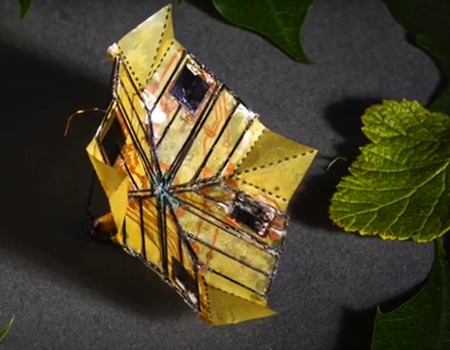 Even though it is an ancient art, many of us equate folded paper with the boats, planes, hats and fortune tellers we made from our homework assignments.
Even though it is an ancient art, many of us equate folded paper with the boats, planes, hats and fortune tellers we made from our homework assignments.
Well, that truly was kid’s play compared to what researchers at the University of Washington are doing with origami, creating small robotic devices that can change their shape in mid-air to conduct a variety of missions.
Out in the wild, these “microfliers” could be mistaken for leaves wafting aimlessly from the sky. But on command – either using onboard sensors or a Bluetooth command from the ground – the device changes its shape to stabilize and slow its descent so it has time to collect valuable information such as temperature, humidity and wind currents. This information can be used for a variety of uses, such as monitoring crop conditions in the field or analyzing changes in the climate.
How do they change shape? The secret is a form of origami called the Miuru-ori fold. In 1985, Japanese astrophysicist Koryo Miuru proposed that this form of origami could be used to create a shape-memory structure that can remember its shape each time it is folded and unfolded. It was successfully used for the solar panels of the Japanese Space Flyer Unit mission in 1995 and has since influenced spinoff designs that allow structures to be packed in a highly compacted state and then open fully into its intended shape in one continuous motion.
Microfliers operate on a similar principle but on a much smaller scale. Though small in size and weight (about 400 milligrams), they have onboard battery-free actuators and solar-power harvesting circuitry that allow them to shape-shift in the air.
If you love data, the electromagnetic actuator that allows the microflier to transition between shapes produces peak forces of up to 200 millinewtons within 25 milliseconds.
According to research published in Science Robotics, the Miura-ori fold opens up new design possibilities for microfliers, partly because of their low weight and low power requirements. Dropped by a drone in tests, they can travel 300 yards when dropped by drone from an altitude of 131 feet.
Researchers are already working on the next steps to see if future microfliers can be designed to allow their direction to be controlled by changing their shapes during flight so they can navigate specific routes and then land in a precise location.